Graph Parameter Editor
Graph parameters are managed by the Graph parameters editor. The main purpose of this editor is to create, edit and remove internal graph parameters, link and unlink external parameter files and edit particular graph parameters in parameter files.
The Graph parameter editor is available via Outline view. Just double-click on the Graph parameters section.
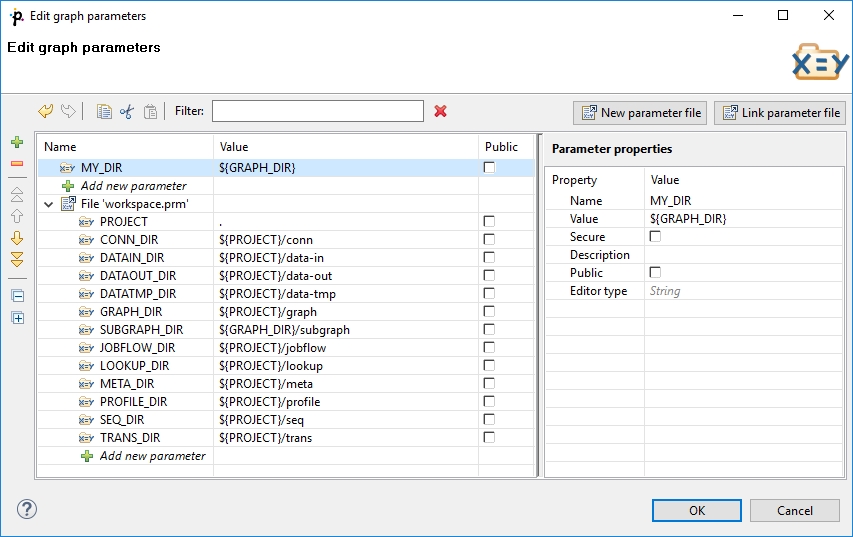
The editor shows the internal and external parameters of the graph simultaneously. Internal parameters are located at the top level of the tree, while external parameters files are shown indented (e.g. workspace.prm in the figure above).
The order of the parameters in the graph defines the priority of use. If parameter names collide, the parameter that is above the other has a higher priority. The order of the graph parameters can be changed using the drag-and-drop actions available on the left toolbar.
If an error is detected in the graph parameters settings, a yellow exclamation mark icon is displayed on the affected graph parameters and an error message is displayed in a tooltip on the damaged graph parameter.
Detailed List of Available Operations
Adding a new graph parameter use To add a new parameter to the end of the list, use in-line editing of Add new parameter cell at the end of each parameter section. To insert a new graph parameter above the current position, use the Plus button on the left side.
Removing a graph parameter Use the Minus button or Delete key to remove selected parameters. Multi-selection is supported. To remove unused graph parameters, use Cleanup Unused Elements.
Name and value editing Edit the name and value of a graph parameter directly in parameters viewer.
Changing the order of parameters Use left-side toolbar (Move top, Move up, Move down, Move bottom) or Drag&Drop to move the selected graph parameter. Order of parameter files can be changed as well. Multi-selection is supported.
Creating a new parameter file Create a new parameter file using the New parameter file button.
Linking an existing parameter file Link an existing parameter file using the Link parameter file button.
Filtering parameters Parameters filtering is based on a substring of parameter name and value.
Dialog supports commonly used operations known from graph editor:
Copy (Ctrl+C), Cut (Ctrl+X) and Paste (Ctrl+V) operation on selected graph parameters.
Undo (Ctrl+Z) and Redo (Ctrl+Y) operations.
Properties of Graph Parameters
Name Identifier of the parameter.
Value Value of the parameter. The Value field can use different editors to edit the value. The editors are set up using property Editor type.
Secure The parameter is considered as a Secure parameter. See Secure Graph Parameters
Description Description is user-defined text for a graph parameter or graph parameter file. Unlike the label, the description can be several paragraphs long.
Public Not used in this version of Data Shaper Designer.
Required Not used in this version of Data Shaper Designer.
Label Not used in this version of Data Shaper Designer.
Value Hint Not used in this version of Data Shaper Designer.
Category Not used in this version of Data Shaper Designer.
Editor Type The public parameters can use a type of editor corresponding to the field of the component using the parameter. For example, you can use File URL Editor or Transform Editor. This field is available for all parameters. The editor type is primarily used for public parameters when setting them in parent graph (when configuring a subgraph).
Graph Parameter Type Editor
The Graph Parameter Type Editor is used to set the correct editor for certain graph parameters. You can choose between Simple Type or Component binding. The dialog is opened from the parameter property Editor type in Graph parameters editor.
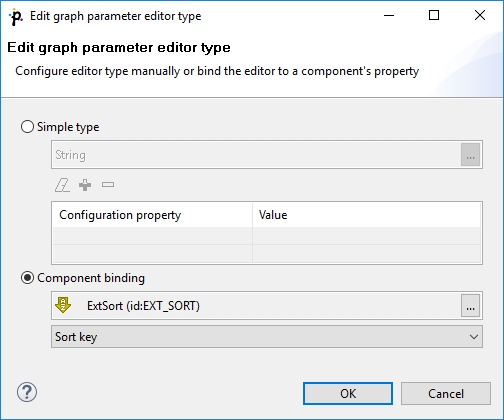
Simple type
Simple type can be one of:
Basic
String - inline editing or external dialog (Edit Parameter Value or Edit Parameter CTL2 Value)
Multiline string - external dialog Multiline String Editor.
Integer - inline editor, allows you to enter only integers
Decimal - inline editor, allows you to enter decimal numbers
Boolean - inline editor - user selects true, false or empty value
Advanced
File URL - external dialog (File Url Dialog). A configuration of the dialog is described in File URL. For details on File URL Dialog, see URL file dialog.
Date/Time - inline editor, allows you to set the date using the calendar.
Properties - inline editor, used to set up key-value pairs. See Properties.
Metadata Related
Single Field - external dialog, allows you to choose one metadata field. See Single Field.
Multiple Fields - external dialog, allows you to choose one or more fields. See Multiple Fields.
Sort Key - external dialog, allows you to define sort key. See Sort Key.
Field Mapping - external editor, allows you to set field mapping. See Field Mapping.
Join Key - external editor, allows you to set fields to be joined. See Join Key
Enumerations
Enumeration - inline or external editor, allows you to choose one option from a list; you may be allowed to define your own value. See Enumeration.
Character set - external dialog, for choosing character set. See Character Set.
Time Zone - external dialog, for choosing time zone. See Time Zone.
Field Type - inline editor, for choosing field data type. See Field Type.
Locale - external dialog, for choosing locale. See Locale.
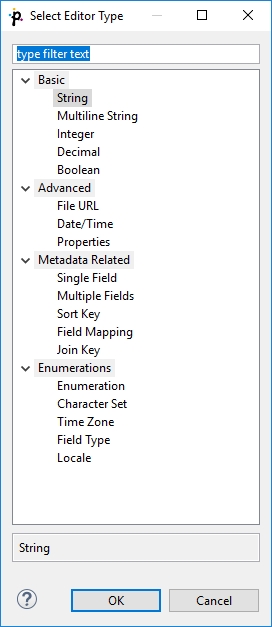
Component Binding
Component binding is not used in this version of Data Shaper Designer.
Edit Parameter Value
Edit Parameter Value is used to set a parameter value. The value of the parameter can be converted to the CTL2 code using the Convert to dynamic button.
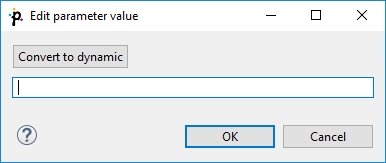
If the Convert to dynamic button is used, the editor is changed.
See also: Edit Parameter CTL2 Value
Edit Parameter CTL2 Value
The Edit Parameter CTL2 Value dialog is used to place a CTL2 code as a parameter value.
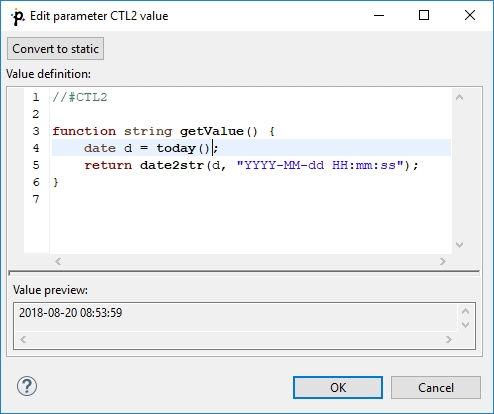
The value can be converted to string using the Convert to static button. If the button is used, the editor changes.
See also: Edit Parameter Value
Multiline String Editor
Multiline string parameter type lets you use a multiline string as a parameter value. If the parameter value is in xml or json format, its syntax can be checked.
Use the Validation configuration property to switch on XML or JSON syntax validation.
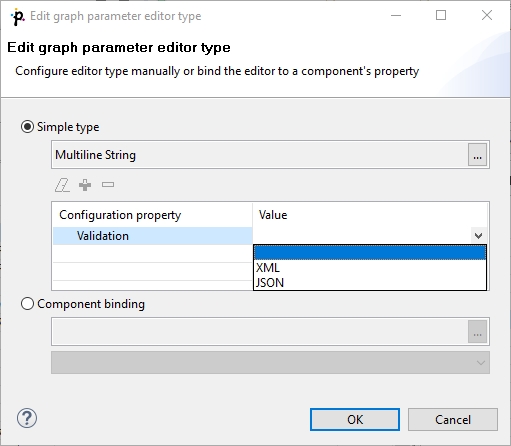
File URL
The File URL parameter type lets you configure File URL Dialog.
File Extension makes a File URL dialog to display files with particular suffix. It can be used to display files matching some patterns too. For example, you can display a txt file (*.txt) or XML files whose name starts with "a" (a*.xml).
Selection Mode displays files or directories or files or directories.
The Allow Multiple Selection checkbox lets you deny multiple file selection. If you uncheck the checkbox, you cannot select multiple files.
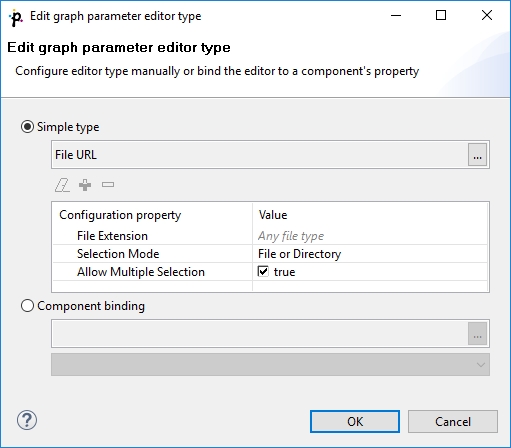
In the Select Types dialog, tick the file extensions to be available in File URL Dialog.
If a suffix is not available in the list, use the Other extensions field below. The suffix you define should start with an asterisk. If more extensions are defined, separate them with a comma.
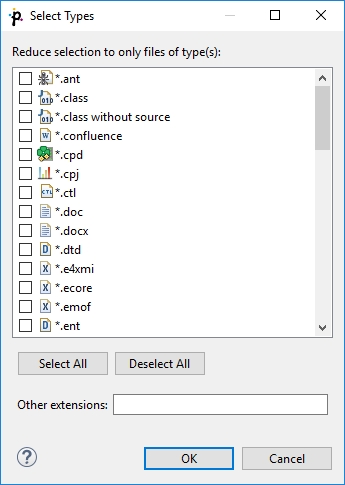
See also URL file dialog.
Properties
The Properties type lets you use key-value pairs.
Properties can be parsed with the function parseProperties.
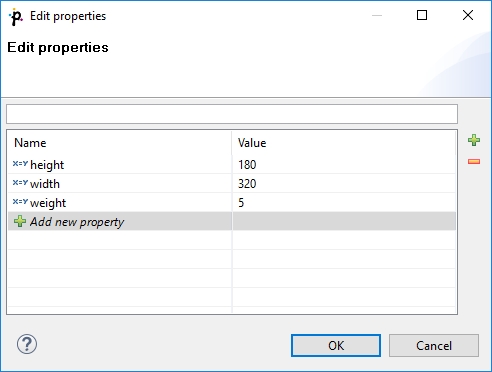
Single Field
The Single Field type allows you to choose one metadata field from the list.
Configuration of Single Field specifies a subset of fields of one existing metadata. You can choose one field of the set. The metadata can be either static or referenced from a particular edge of the subgraph. Available metadata fields can be filtered depending on the metadata field type or on the container type.
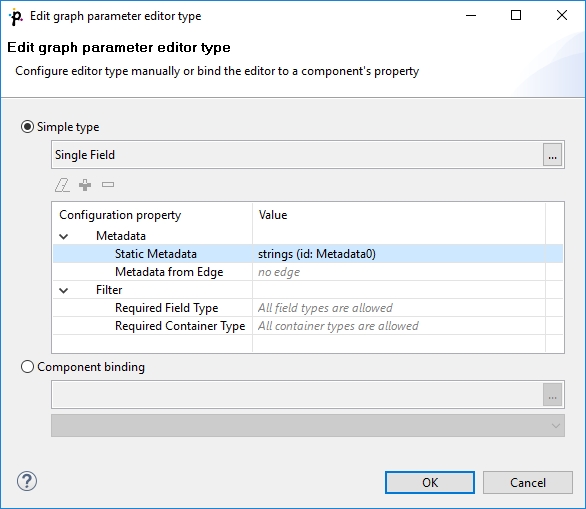
If you use the parameter, you can choose one field using the following dialog.
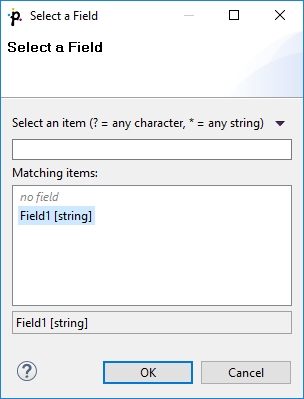
Multiple Fields
The Multiple Fields parameter type is used to choose one or more metadata fields from the set.
The available fields are a subset of the existing metadata fields. The fields can be static metadata fields or edge metadata fields. Available metadata fields can be filtered by metadata field type or container type.
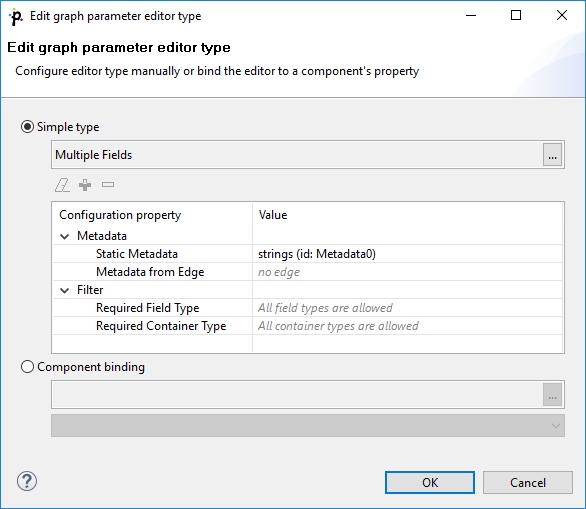
To add fields to the list, you can use the arrows or drag and drop.
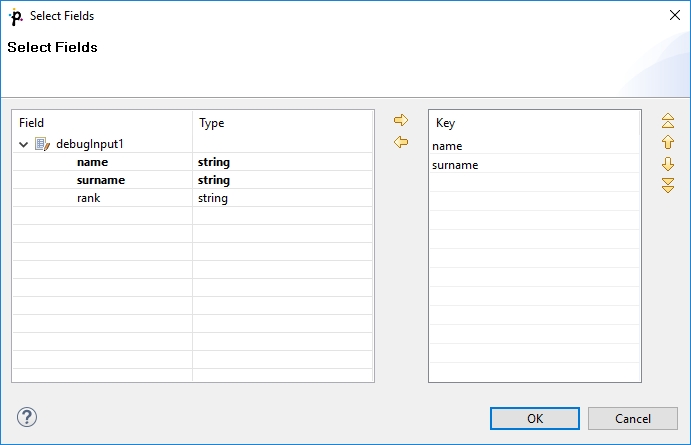
Field Mapping
The Field Mapping type requires metadata from both sides of the mapping. You specify the fields whose metadata can be mapped using the parameter.
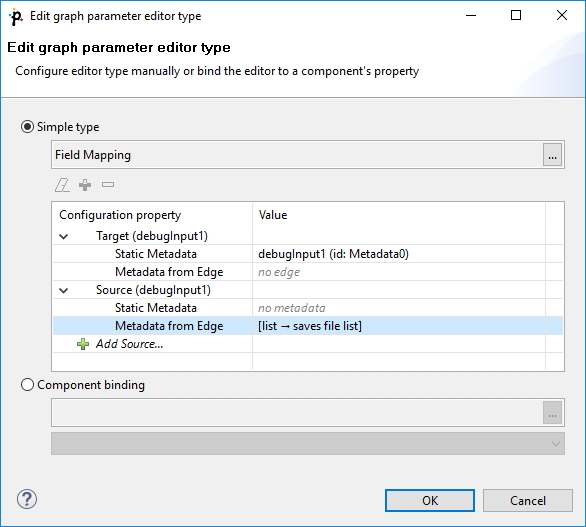
In the Field Mapping dialog, you can define the mapping for the transformation.
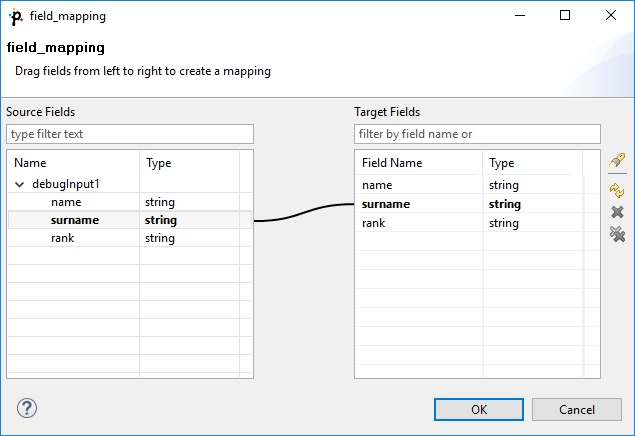
See also Mapping Functions.
Join Key
When you define the Join Key parameter type, you choose which metadata is involved in the join:

The Join Key parameter value specifies joining fields.
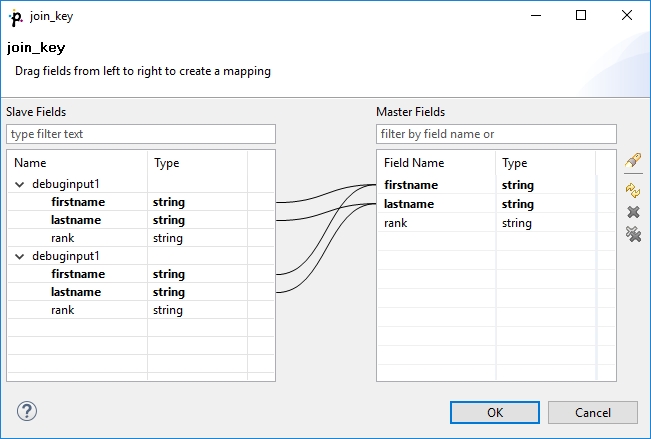
See also Mapping Functions.
Enumeration
The following dialog box is used to set the values available in the Enumeration selection list. The values available in the list are defined in Values. The pipe character is displayed escaped, the semicolon is surrounded by the " character.
User-defined values are allowed using the Allow Custom Value checkbox.
You can choose the value using the inline editor. If more than 10 (ten) values have been defined, you can choose the value using the external dialog box.
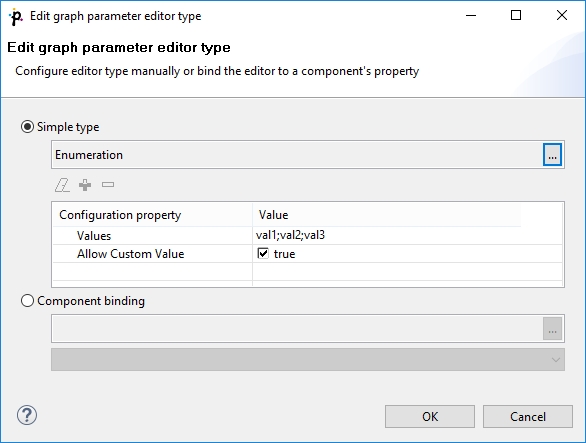
Character Set
The Character set parameter type lets you choose one of the available character sets.

Time Zone
Time Zone allows you to choose time zone from a list. Java or Joda time zones can be used.
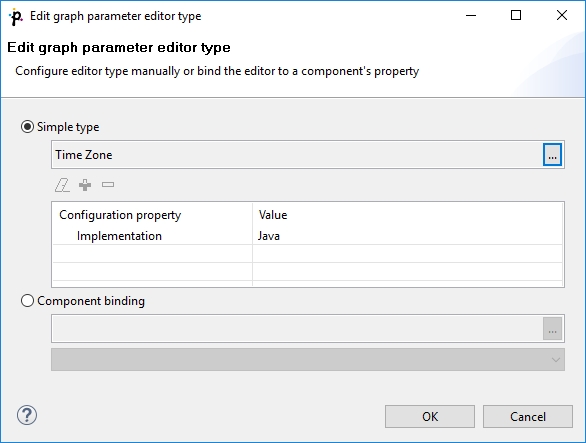
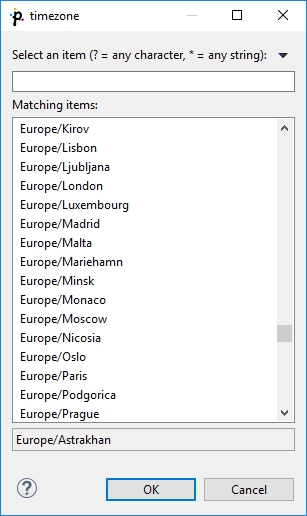
Field Type
Field Type allows you to choose a field type from a list.
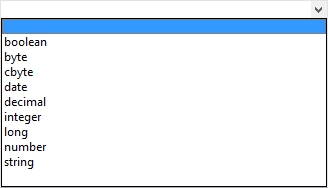
Locale
Locale allows you to set the locale.

Last updated